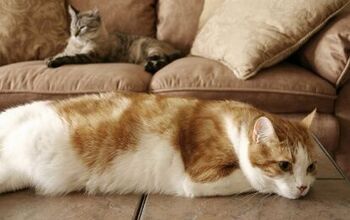What Does Your Cat's Poop Reveal About Their Health?

Every day, countless cat parents do the not-so-pleasant job of scooping the litter box. While this routine task may not be the most glamorous, your cat’s box holds a wealth of information about their inner workings and overall health.
Paying just a little attention to what they leave behind may reveal subtle clues that speak volumes about their well-being.
In this post, I will share the knowledge you need to decipher the unspoken language of the litter box, including helping you understand what constitutes a healthy deposit and, more importantly, when something may be “off” or warrant a call to your veterinarian.
Familiarizing yourself with what to look for and when to be concerned is the key to a happier, healthier life for your best friend.
What is Considered “Normal” Cat Poop?
Recognizing when something isn’t right based on your cat’s litter box starts with understanding what is considered “normal.” There are several key characteristics that you can expect to see when looking at health cat poop, indicating a well-functioning digestive system.
Consistency is Key
Ideally, your cat’s stool should be firm and log-shaped, holding its form well when scooped. The texture should be moist, like the texture of modeling clay or even a well-formed sausage. This consistency is important as it means the food is being properly digested and there’s a healthy balance of water absorption in the intestines, resulting in poop that is easy and comfortable to pass through the digestive tract.
The Right Color
The expected color for healthy cat poop falls into a spectrum that ranges from medium to dark brown. This comes primarily from the natural breakdown of food within the digestive system and the presence of bile, the key digestive fluid produced by the liver.
It is worth noting that slight color variations can happen due to the foods included in your cat’s diet. For example, certain foods may cause the poop to be slightly lighter or darker brown, which is usually nothing to be concerned about as long as other characteristics on this list remain normal. If you do notice a slight change of color, take a moment to consider whether your cat has eaten something new recently that could be behind that shift.
Size Matters
The typical size of a healthy stool for your cat will correlate with their overall size and the amount they eat, meaning that it will vary slightly from cat to cat. Even within my own home, with three cats, we have three different “normals” to consider.
By consistently observing your cat’s waste when cleaning the box, you will familiarize yourself with what is normal for them, allowing you to notice if their waste is slightly smaller or larger than usual, which can be a subtle sign of an underlying issue. Very small stools may suggest that your cat is eating less than usual or they are experiencing a slower digestion rate than normal. Consistently large stools could point towards dietary imbalances or improper absorption of nutrients.
Something Smells “Off”
Let’s be honest, all poop has an odor, and it’s not an odor we generally get excited about. However, healthy cat poop shouldn’t have an overwhelmingly foul or offensive smell. While you won’t be mistaking your cat’s litter box for roses anytime soon, even if they are 100% healthy, a sudden and significant worsening of that smell can be a red flag. This may signal bacterial overgrowth in the digestive tract or digestive upset. Trust your nose – if the smell seems noticeably different and concerning, it’s worth taking note and investigating further.
Frequency and Habits
Most cats will typically have a bowel movement once or twice a day. This is considered “normal” and indicates that their digestive system is operating as it should. Still, it can vary slightly from cat to cat based on factors such as their diet, activity levels, and overall metabolism. Monitoring your cat’s bathroom habits can help you establish what’s normal for them, arming you with the information necessary to recognize if something’s “off.”
A significant and persistent change in their usual bathroom habits, whether it’s going much more or much less often, is a red flag worth paying attention to.
Red Flags in Your Cat’s Litter Box
While understanding what healthy poop looks like will give you a baseline, you will need to fine tune your observation skills to be able to recognize when something has changed, even subtly. Certain changes in consistency, color, contents, odor, frequency, or volume may signal underlying issues that need to be addressed or even a need for a visit to the veterinarian ASAP.
Here are a few of the red flags you should be on the lookout for in more detail:
Changes in Consistency
One of the most common changes you may notice is diarrhea, which can manifest in several forms. It may appear watery, very loose, or have a soft, puddling-like consistency. Several factors can contribute to diarrhea in cats. Often, it is the result of eating something they shouldn’t. However, stress, parasites (such as roundworms, hookworms, or Giardia), bacterial or viral infections, food sensitivities or allergies, and even underlying medical conditions can impact the digestive tract.
It's also important to keep in mind that diarrhea can quickly lead to dehydration, especially in vulnerable populations like kittens and senior cats, making prompt attention critical.
On the opposite end of the spectrum is constipation, characterized by hard, dry pellets or infrequent and often strained attempts to go. You may notice your cat making repeated trips to the litter box without producing much or showing signs of discomfort when trying.
Dehydration is also a significant contributor to constipation, as is a diet lacking the necessary fiber your cat requires. Hairballs, particularly in long-haired breeds, can also cause blockages. Other potential causes include obesity, pain (making it uncomfortable to get into position to go), neurological issues, and, in severe cases, a condition called megacolon, where the colon becomes enlarged and loses its ability to contract and move the stool along effectively.
Constipation can be pretty uncomfortable for your cat and, if left untreated, can lead to serious medical problems.
Changes in Color
If your cat’s poop isn’t in the usual brown spectrum of color, it could be a sign of trouble. Here are some of the most common color changes to be aware of:
- Black, Tarry Stools (Melena): This serious red flag typically indicates bleeding in the upper part of your cat’s digestive tract, such as the stomach or small intestine. The dark, tarry appearance is due to the blood being digested as it passes through. Potential causes can include ulcers, tumors, trauma, or other conditions that cause bleeding in these areas. If you see this, contact your veterinarian immediately, as it could be a sign of serious underlying health issues.
- Red Streaks or Fresh Blood (Hematochezia): Red streaks or the presence of fresh, bright red blood in your cat’s stool usually points to bleeding in the lower part of the digestive tract, specifically the colon or rectum. This blood hasn’t been digested, hence its bright red color. Common causes include constipation (leading to straining and potential tears), colitis (inflammation of the colon), parasites, or issues with the anal glands. While this is sometimes less critical than melena, it still should be investigated by your vet as soon as possible.
- Yellow or Pale Gray: If your cat’s poop has a yellow color or a pale clay-like gray appearance, it could suggest problems with the liver, gallbladder, or pancreas. These organs all play crucial roles in digestion, including the production and release of bile, which contributes to that characteristic brown color. If these organs aren’t functioning properly, the lack of bile can affect the color of the stool. For a proper diagnosis, your cat will need to see a vet.
- Greenish Stool: While less alarming than black or pale stools, a persistent green tint to your cat’s waste could be a sign that the digestive system is moving food through too quickly, meaning that food isn’t being processed and digested as thoroughly as it should. It can also be explained by your cat eating certain things with a green appearance, like large amounts of grass. While this isn’t an immediate medical emergency, it is worth discussing with your vet.
When You See More Than Just Poop
If you are cleaning your cat’s litter box and notice more than just the usual waste, you may be concerned – and for good reason. No one expects to discover unusual contents beyond poop lingering. Here are a few things to watch out for:
- Visible Worms: Anytime you see visible worms in your cat’s stool, it is a clear sign of a parasitic infestation that needs to be addressed. Roundworms often resemble spaghetti strands, while tapeworm segments look like small grains of rice, sometimes moving and wriggling. Regular deworming, as recommended by your veterinarian, is essential to prevent and treat these internal parasites, as they can rob your cat of vital nutrients from their food and cause other health issues.
- Excessive Mucus: A small amount of mucus in your cat’s poop is not always cause for concern, as it can work to help lubricate the passage of stool through the digestive tract. However, noticing a consistently large amount of mucus may indicate inflammation in the intestines (colitis). This inflammation can be triggered by many factors, including dietary sensitivities, parasites, or inflammatory bowel disease.
- Undigested Food: If you find significant amounts of undigested food particles in your cat’s poop, it may suggest there is an issue with their digestive system’s ability to break that food down properly. It could also be a sign that they are eating too quickly, not allowing time for digestion to begin in the mouth. Small, occasional pieces of undigested food are not overly concerning. However, if you are consistently seeing these particles, it warrants a trip to the vet.
- Excessive Hair: It’s normal for cats to pass some hair in their stool due to grooming. However, if you consistently find large amounts of hair in their waste, it could be a red flag of overgrooming, which is often due to stress or skin issues. There is also an increased risk of a hairball forming in the digestive tract, which can lead to vomiting and, in the most severe cases, a potentially life-threatening blockage.
Changes in Odor
As mentioned earlier, a sudden and significantly more foul and disturbing odor than usual can be a sign of bacterial overgrowth or an imbalance in the gut microbiome. This can happen due to dietary changes, infections, or other disturbances within your cat’s digestive tract.
Changes in Frequency
A noticeable and persistent increase or decrease in the frequency of your cat’s bowel movements is a sign of trouble. Going much more often could be linked to diarrhea or malabsorption, while going significantly less than usual could indicate constipation or a blockage. Call your vet and explain your concerns. They know your cat’s unique medical history and can recommend how to move forward with their health in mind.
Changes in Volume
If your cat consistently produces large volumes of stool, it may suggest that they aren’t absorbing nutrients from their food properly, leading to more waste. On the other end of the spectrum, constantly small volumes could mean they are eating less, or their digestive process has slowed down. Both are concerning when it comes to your cat’s ongoing health and well-being.
Tips to Support Healthy Digestion in Your Cat
The secret to consistent, healthy poops is a healthy digestive system. Luckily, you can take steps to prioritize your cat’s digestive health and set them up for success.
- High-Quality Diet: Feed a balanced, species-appropriate diet with the fiber necessary to promote regularity. If you are unsure whether your cat’s diet is ideal, consider contacting your vet or a nutritionist for guidance.
- Proper Hydration: Always make sure your cat has access to fresh, clean water. Proper hydration is key in maintaining healthy stool consistency and preventing constipation. If you are worried your cat isn’t drinking enough, a pet water fountain can help. We have seen a significant increase in the water our cats consume since introducing the Catit Flower Fountain.
- Regular Grooming: Regularly brushing your cat can help reduce the amount of hair they ingest, lowering the risk of hairballs and the digestive upset they can trigger. If your cat regularly struggles with hairballs, you may want to try a supplement like NaturVet Hairball Aid.
- Appropriate Litter Box Management: Maintaining a clean litter box is not only crucial for encouraging your cat to go to the bathroom regularly, but it also makes it easier for you to monitor their stool for signs of trouble. Ensure you have an appropriate number of litter boxes (the general rule of thumb is one per cat plus one extra) placed in accessible and private locations around the house.
- Reduce Stress: Try to minimize stress in your cat’s environment whenever possible, as stress can negatively impact their digestive system and lead to changes in their stool.
- Regular Vet Check-ups: Don’t underestimate the importance of your cat’s regular vet checkups. These appointments allow your vet to identify potential health issues early, sometimes even before obvious changes in your cat’s poop occur.
Become a Litter Box Savvy Cat Parent
Ultimately, paying close attention to your cat’s litter box habits and the state of their waste is a vital step in prioritizing your cat’s health and well-being. If you aren’t already, I encourage you to become familiar with what “normal” looks like for your cat asap and establish a baseline to make it easier to identify any potential red flags. This commitment to your cat will contribute significantly to their long-term health, allowing you to enjoy many more healthy years together.
Join the PetGuide community. Get the latest pet news and product recommendations by subscribing to our newsletter here.

Britt Kascjak is a proud pet mom, sharing her heart (and her home) with her “pack” which includes her husband John, their 2 dogs – Lucifer and Willow – and their 3 cats – Pippen, Jinx, and Theia. She has been active in the animal rescue community for over 15 years, volunteering, fostering and advocating for organizations across Canada and the US. In her free time, she enjoys traveling around the country camping, hiking, and canoeing with her pets.
More by Britt
























